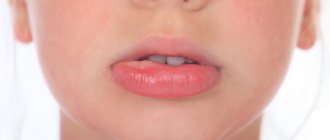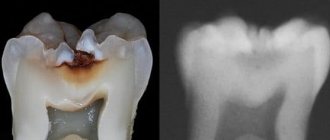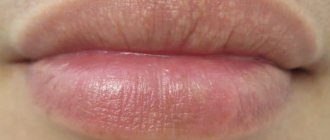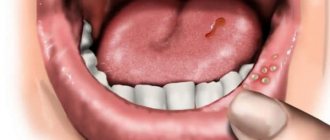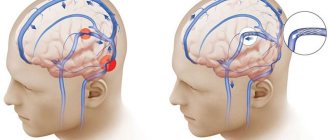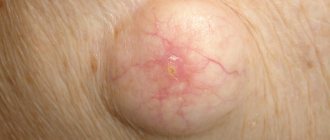Often we are faced with the problem of the appearance of so-called boils in the cheek area. It looks ugly and not aesthetically pleasing, but besides this, a boil on the cheek is also dangerous, as it can cause serious complications. The blood supply to the face in the triangle area is quite intense, which means that from the infected area the infection can enter the bloodstream, which will spread it throughout the body. The greatest danger in this case is the likelihood of contracting a brain infection.
Boil on the neck, an extremely dangerous phenomenon
Distinctive features of a boil
Furunculosis on the face appears in the following cases:
- a rather dense subcutaneous formation on the face,
- when compared with a regular pimple, a boil has a much larger lesion,
- gradual increase in the inflamed area,
- an abscess located in the upper part does not appear immediately,
- painful sensations, especially when touched.
A boil on the cheek is always bacterial in nature, which means that some microorganism is actively working and multiplying inside the inflamed area.
How not to damage your appearance
To maintain the beauty and health of your facial skin, you need to follow some rules:
- It is forbidden to squeeze, scratch, or pierce boils, as this may provoke internal opening of the purulent capsule. Will lead to swelling, spread of infection, complications. Squeezing increases the risk of subsequent scarring and scarring on the facial skin.
- It is unacceptable to heat a ripe boil.
- Going to a bathhouse, sauna, swimming pools, or public bathing places is contraindicated.
- It is better to avoid using cosmetics during the development of a boil and until the wound has completely healed. Some drugs can provoke the opening of an abscess and lead to the development of dangerous consequences.
- If the boil is located in the nasolabial triangle, on the chin, men should refrain from shaving. There is a high risk of damage to the abscess.
- Scrubs, masks, and abrasives are not used.
- After washing, dry your face carefully, without unnecessary friction.
- The use of medications without prescription is contraindicated. A person who decides to treat himself may worsen the situation. Delay the healing process and cause increased symptoms.
By following the recommendations step by step, a person will be able to get rid of abscesses quickly, painlessly, with minimal risks to their own appearance.
Why does furunculosis occur on the face?
When boils appear on your face, it is imperative to identify the cause, because the result of treatment and its effectiveness will depend on this. Staphylococcus aureus, the most basic etiology for the occurrence of furunculosis. This is an infection that penetrates a wound on the skin and causes an inflammatory process. However, such a process can be started if your skin has poor protection function. For example, you have:
- thin skin that is easily damaged,
- rashes, acne, inflammatory processes on the skin,
- excess acid-fat mantle in the skin, and as a result, poor protection against inflammation,
- fluid-soaked and swollen skin (with various diseases, such as eczema),
- contaminated skin surface with clogged pores.
The following may also be causes of weakened skin:
- fungal skin disease
- liver dysfunction, which plays an important role in blood purification,
- weakened immunity, resulting in a minor infection that can cause serious inflammatory processes,
- chronic diseases,
- metabolic disorders, complications in the functioning of the endocrine system,
- taking antibiotics for a long time,
- taking hormonal medications, treatment with serious drugs that affect the immune system,
- disruption of the gastrointestinal tract,
- chronic infections with discharge of pus and mucus that can get on the surface of the skin, vitamin deficiency.
Gastrointestinal problems affect the occurrence of boils
Features of localization of boils on the cheek
A boil in the cheek area is easy to recognize if you know its characteristic features:
- The pustular formation looks like a regular pimple. A distinctive feature is the pronounced hard structure and painfulness of the boil.
- The development of purulent-necrotic formation is accompanied by the spread of inflammation to neighboring areas. The size of the pathological focus increases sharply.
- The abscess lies deep in the thickness of the skin.
- The center of formation is represented by a whitish head (the shaft of the boil).
- In the phase of boil maturation, the inflammatory process is accompanied by pain during eating, movements of the lower jaw, and hygiene procedures.
- The clinical picture of the pathological condition is characterized by an increase in temperature to subfebrile levels.
- When the abscess breaks, the severity of the listed symptoms decreases.
The danger of a boil is determined by its location. Localization of the abscess on the cheek threatens the spread of the inflammatory process to the brain.
Need advice from an experienced doctor?
Get a doctor's consultation online. Ask your question right now.
Ask a free question
The presence of an inflamed area above the mouth line is accompanied by a high risk of developing life-threatening conditions of internal organs. Through a well-developed vascular system, staphylococci enter the vessels of the head, brain and spinal cord. Cavernous sinus thrombosis, abscess or phlegmon, encephalitis, and meningitis develop. All conditions can be fatal. The high risk of complications is associated with incorrect diagnosis of the condition by doctors and patients. Patients may confuse a boil with a formation on the inside of the cheek. The formation does not occur on the oral mucosa. There is no hair here.
A boil in the mouth on the cheek is a myth! The absence of hair automatically excludes boils. Aphthous stomatitis, fungal infections, benign and malignant formations can occur on the oral mucosa. For a correct diagnosis, you need to consult a doctor who will competently approach the identification of the cause of the disease and differentiation of the pathological focus. The patient is prescribed additional research methods (general clinical tests, bacteriological culture from the source of infection).
How to recognize a boil?
If you find inflammation on your face and there is a suspicion of furunculosis, then you should pay attention to the fact that the boil forms in several stages, which takes on average about 30 days.
Stage 1, infiltration. An infection that has entered a suitable habitat begins to actively develop, which may result in itching and pain around the affected area. Over time, the surface of the skin becomes denser and reddens. The inflamed accumulation in the tissues gradually grows, swells and becomes denser. And the pain intensifies even more.
Stage 2, suppuration. After a few days (about 3-4 on average), a rod with pus forms in the very center of the inflammatory area. Externally, it is presented in the form of a purulent pustule. In such a situation, there may be an increase in temperature and increased pain. After this, the thin skin over the so-called purulent cap breaks and the pus begins to come out. During this process, the pain decreases. The purulent rod secretes pus of a certain color.
Stage 3, healing. When purulent fluid is released, the swelling subsides, and the pain becomes much less, after which a pronounced small scar appears, over time it changes its color to a darker one and is practically invisible.
In the first stage, the infection causes pain and redness
Prevention
To prevent your child from developing a boil, you should follow some preventive measures:
- The diet should not contain a lot of sweets and fatty foods. It is desirable that the menu include more dark green vegetables.
- A child needs a daily dose of vitamin C and the entire group of B vitamins. A sufficient amount of these substances is contained in rose hips and citrus fruits. If a child is sick, it is advisable to give him rosehip tincture 3-4 times a day. After all, in a weakened body there is a high probability of a boil appearing.
- Constant personal hygiene. Your child's skin should always be clean. It is worth explaining to him that you cannot touch your skin with dirty hands.
- Any wounds, scratches, or bites should be immediately treated with an alcohol solution, iodine or brilliant green.
If a course of treatment has already been prescribed by a doctor, then it is advisable to include iron intake in it. This microelement will block the further spread of the inflammatory process.
Very often, with a weakened immune system, a boil appears in a child - a purulent abscess. This is an acute inflammation of the hair follicles, sebaceous glands and connective tissue. Caused by pyogenic bacteria, most often Staphylococcus aureus. Causes a lot of suffering to children and worries to their parents.
If single formations are easy to deal with, then extensive skin lesions with multiple ulcers are already a disease - furunculosis - and require full treatment.
Doctors name different reasons for the formation of a boil on a child’s skin. Its appearance can be triggered by factors such as:
- constant skin contamination;
- microtraumas (abrasions, scratching, splinters, scratches);
- unhealthy diet;
- weakened immunity;
- a boil in an infant is a consequence of improper skin care and poor hygiene;
- sweating;
- increased sebum secretion;
- impaired metabolism;
- avitaminosis;
- lack of fresh air;
- diabetes;
- problems with the endocrine system;
- Often a boil in children forms in the nose due to the fact that they constantly pick there with dirty hands and get a runny nose;
- hypothermia or overheating of the body;
- long-term use of certain glucocorticosteroid drugs;
- colds and infections (hepatitis, tuberculosis);
- hairs ingrown into the skin;
- severe diseases: sore throat, pneumonia, bronchitis, etc.
- stressful situation.
If a boil is discovered on a child’s body, parents should think about what caused it. And in the future, it is advisable to avoid such mistakes by protecting the baby from provoking factors.
If it was not possible to avoid the misfortune, you need to seek professional help as soon as possible. Sometimes it is difficult for parents to differentiate furunculosis from other skin diseases, especially since there are different types of ulcers.
Origin of name. The medical term "boil" comes from the Latin "furunculus", which translates as "to be angry, to become enraged."
Due to the fact that various factors can cause the appearance of boils on a child’s body, as well as due to the individual characteristics of the body and age, ulcers can be different. Dermatologists have a whole classification based on external symptoms and localization of the purulent process.
- A boil is a single abscess.
- A carbuncle is an extensive abscess that covers several follicles at once. That is, many abscesses merge with each other. In such cases, their contents come to the surface in many places.
- Cystic acne furunculosis. Inflammation and suppuration occur in the deep layers of the skin. Usually diagnosed on the face of adolescents.
- The pilonidal sinus is a very painful boil in the intergluteal fold. The reason is a sedentary, sedentary lifestyle. Obese children with high weight are at risk. Over time, a painful node forms on the butt.
- Hidradenitis suppurativa is multiple ulcers that occur due to inflammation of the sweat glands. Usually localized in the armpits or groin area. There is no necrotic core in boils. Antibiotics are not enough for treatment: mandatory surgery is required to remove sweat glands that have undergone an inflammatory process.
Different types of boils in children allow us to treat each of them individually. What is used to treat carbuncle is not suitable for the pilonidal sinus. And the treatment of an abscess on a child’s eye will differ significantly from the treatment of the same abscess on the abdomen. But before you look for methods to get rid of them, you need to make sure that it is really a boil.
Other names. Doctors call a neglected boil a carbuncle, and in common parlance it is called a “boil.”
Parents often confuse a boil on a child’s body with an ordinary pimple, and this becomes a total mistake. Thinking that this is a minor abscess that goes away on its own, they do not treat it in any way. The result is all sorts of complications, including sepsis. Therefore, it is so important to suspect in time that this is a boil, based on the following characteristic symptoms:
- the appearance of a single pustule on the skin: it rises above the skin, is distinguished by a bright red halo around a dense and edematous abscess, where a core forms;
- after 3-4 days, a white dot forms at the top of the abscess (there is pus under the thin film);
- a boil is a very painful neoplasm;
- in this place the child feels unpleasant tingling and itching;
- it can occur in any part of the body where there is hair;
- enlargement of nearby lymph nodes due to the inflammatory process;
- temperature can rise to 39°C;
- the child becomes lethargic, capricious, sleeps poorly, and refuses to eat.
The entire process from the beginning of the formation of an abscess to its complete disappearance takes about 10 days. It includes several stages:
- Infiltration. Formation of painful compaction, swelling.
- Suppuration, necrosis. The infection is activated, intoxication occurs, and a core is formed.
- Recovery, healing. Formation of granulation tissue and scar. Blue and pale discoloration of inflamed tissue.
The main difference between a boil and a pimple is the long period of ripening and extreme pain. It is not always able to pass on its own. To alleviate the child’s condition, he should be shown to a doctor and, if necessary, undergo a course of treatment, but only after appropriate diagnosis.
Interesting fact. The famous Russian composer A. N. Scriabin once squeezed out a boil on the nasolabial triangle, but he did it extremely unsuccessfully: he developed sepsis, from which he died.
Treatment methods
A boil on the cheek must be treated comprehensively under the supervision of a dermatologist and strictly following all his recommendations. In case of complicated course of the disease, elevated temperature, chills, intoxication, treatment in a hospital is necessary. In other cases, the specialist will give detailed recommendations for effective treatment at home, but there are procedures that still require a trip to a specialized medical institution.
- Treatment with antiseptic agents. Before the boil on the cheek matures, it is necessary to treat the affected area with 70% alcohol, salicylic alcohol, or calendula tincture, furocylin solution. This procedure is performed in order to prevent the spread of infection. The affected inflammatory area should be carefully wiped with an antiseptic several times a day, without sharp pressure. It is also recommended to change bed linen more often, in this situation this applies to pillowcases.
- Physiotherapeutic treatment. When the boil is already at the healing stage, the use of ultraviolet therapy will be effective, which will promote rapid tissue regeneration and disinfection of the wound. In order for the abscess to mature more quickly, UHF or laser therapy can be used. These procedures must be carried out in a physiotherapy room. It is important to remember that independent use of dry heat at home is highly discouraged, as careless application can complicate the situation. A special ichthyol patch should be applied to the boil, which will promote rapid maturation of the abscess and reduce pain.
- Antibiotics. In cases where the disease with furunculosis is chronic, antibiotics with a broad spectrum of action are prescribed in order to avoid complications and promote a speedy recovery. Antibiotics are prescribed even before the boil matures. And after the abscess opens and its contents are examined, the drugs used can be reconsidered.
Before the boil ruptures, it is not recommended to use various antibiotic-based ointments, since they can soften the skin tissue, and this can lead to infection in the blood.
If you have a boil on your neck, you should change your pillowcases often.
Clinical and diagnostic signs
Squamous cell cancer of the skin, larynx, stomach, esophagus, lung, cervix and other organs - causes and mechanisms of development, types, stages and symptoms, diagnosis and treatment, prognosis
In patients with a boil on the face, complaints depend on the localization of the pathology, depth of the lesion, development complications. Common symptoms include:
- sudden rises in body temperature to high numbers;
- general weakness;
- pain in the affected area;
- sweating
If there is a boil on the cheek near the palpebral fissure, the patient presents the following complaints:
- swelling of the eyelids;
- increased pain with frequent blinking, facial movements;
- swelling of the entire cheek;
- headache.
When a boil develops on the chin, it is accompanied by:
- swelling of the lips;
- severe pain when opening the mouth while eating solid food;
- swelling of the nearby cheek.
Pulsating constant pain is typical for patients who have a boil on their temple.
This clinical picture is due to the peculiarities of the anatomical structure - a minimal layer of subcutaneous fatty tissue, abundant blood supply. Boils on the face of this location are accompanied by a constant headache. Opening them often leads to minor bleeding. Diagnosing abscesses on the face is not difficult for a specialist. Surgeons and dermatologists deal with this pathology. The final diagnosis is made at the initial visit based on:
- patient complaints;
- history of the disease and life, because with boils on the face, the causes and treatment are closely interrelated;
- characteristic objective picture.
Additional examination is prescribed if repeated and multiple boils form on the chin, cheeks, and temples. The following studies are recommended:
- General blood analysis.
- Immunological tests.
- Biochemical blood test with determination of acute phase parameters.
- A smear-imprint from the affected area of the skin.
- Bacteriology of the contents of an abscess in order to identify the pathogen and determine its sensitivity to antimicrobial drugs. The downside is the length of time it takes to conduct and evaluate the results (up to 7 days).
Examinations are performed on an outpatient basis. They help the doctor understand how to get rid of a boil on the face for a long time. Taking into account the data obtained, the treatment regimen is adjusted.
Treatment with surgical methods
A boil that has formed on the face must be opened so that the inflamed area can be cleansed as quickly as possible and there are no complications. The opening of a mature abscess is performed under special conditions; local anesthesia is used if necessary.
The opened abscess is cleaned of pus, disinfected with hydrogen peroxide, after which the wound is drained by applying a bandage with a hypertonic solution in order to remove the remaining pus. The bandage needs to be changed periodically. If the abscess is abscessed, then after opening it is recommended to apply bandages with special ointments (Levomekol, Syntomycin ointment). After time, Vishnevsky ointment is prescribed to speed up the healing process.
In addition, the following recommendations must be followed:
- the face and facial muscles must be kept at rest, this is necessary so that the inflammation process proceeds favorably,
- follow a properly selected diet, which does not contain food that requires long and thorough chewing, that is, hard,
- use special immunostimulating drugs in cases where the boil has relapsed.
Autohemotherapy is also being considered. This procedure involves administering your own blood intramuscularly according to a specially designed course. However, the procedure can be carried out only after complete recovery from furunculosis.
After the boil has healed, a scar remains on the face. For its treatment, absorbable ointments are often prescribed to promote the regeneration of damaged tissue.
Boils leave scars on the face
Causes of boils in a child
The causative agent is Staphylococcus aureus. When the body's immune forces change and resistance to external influences decreases, the microorganism acquires pathogenic properties and, penetrating through the protective barrier of the skin, causes inflammation of the hair follicle. The situation is further aggravated by the fact that children have an immature immune system and immunity to Staphylococcus aureus has not yet developed. Staphylococcus can penetrate the skin through lesions.
It is opened surgically if it does not open on its own. This is usually done under local anesthesia in the doctor's office (except in cases of severe sepsis).
Reasons for appearance
Conventionally, all types of oral ulcers can be combined into 2 broad groups:
- ulcers, the formation of which is associated with damage to the tissues of the oral mucosa;
- ulcers as symptoms of another disease.
First, let's look at the causes of ulcers due to damage to the mucous membrane and tissues of the oral cavity. These include:
- Stomatitis – sores of an infectious nature;
- Injuries – ulcers of traumatic origin.
Nasal boil in children
A nasal boil is most often located on the inner surface of the wings of the nose or on the tip of the nose. The following clinical signs are characteristic of a nasal boil: the appearance of an area of redness and swelling, a pinpoint abscess at the height of the cone, pain at the site of inflammation, increased pain when touching the site of inflammation. Due to the fact that the venous and lymphatic system of the nasal area is anatomically connected with the venous and lymphatic system of the eye and brain areas, a nasal boil can be complicated by the introduction of infection into the orbital area, inside the skull. In this regard, we must say the following: in order to avoid the development of dangerous complications, you cannot pierce the boils of the nose yourself, you cannot squeeze out the pus or the rod from the boils.
It is recommended to provide the following assistance to a child with a nasal boil:
- start taking an antibiotic (for example, erythromycin) or some sulfonamide drug at an age-related dose;
- apply a sterile gauze pad with syntomycin emulsion or antibiotic ointment applied to the boil - erythromycin, tetracycline, etc.;
- if there is an increase in body temperature, if the child complains of a headache, you need to urgently call a doctor or take the child to the clinic.
How to avoid dangerous complications
The danger of cheek furunculosis is the high risk of complications. Abscesses and phlegmon often form due to improper and untimely treatment. To prevent them, the following precautions must be observed:
- Doctors prohibit massaging the boil. Active movements can provoke the widespread spread of staphylococci throughout the body. They enter through the blood and lymph into the membranes of the brain and spinal cord.
- You cannot mechanically influence the affected cheek with your hands and improvised instruments (squeeze, pierce the boil). Otherwise, there is a high risk of pathogenic microorganisms entering the blood and spreading throughout the internal organs and systems. Only a surgeon can quickly act on the area of inflammation.
- Pathological formation must be promptly identified and treated. Advanced cases of the disease threaten the occurrence of the above consequences.
- The affected cheek requires special hygienic care.
- The area of inflammation should be treated daily with antiseptic solutions. Before applying the compress, you need to disinfect the inflamed surface.
- Timely antibiotic therapy plays an important role in the prevention of complications of cheek boils. Antimicrobial drugs act on the underlying cause of the pathology. Antibiotics stop the proliferation of staphylococci.
The correct approach to the treatment of the pathological condition of the cheek will help prevent adverse consequences for human health.
A boil is a purulent inflammatory process caused by inflammation of the hair follicle. This formation looks like a swollen lump, is quite painful and occurs on any part of the body. If a boil appears on the face, you will need urgent help from a specialist, because such a location of the boil can have bad consequences.
In most cases, ulcers are accompanied by itching, the pain only bothers you when you touch the affected area of the skin, but in severe cases the temperature may rise and your health may worsen. Boils bring a lot of anxiety to children, especially if they are localized on the face.
Classification of oral abscesses
The classification of abscesses is based on their location in the oral cavity.
Thus, the following formations are distinguished:
- gum abscess.
- abscess of the floor of the mouth.
- abscess of the palate.
- cheek abscess.
- tongue abscess.
A purulent process that is diagnosed in dentistry more often than others. The main location of the abscess is the gum near a tooth. If treatment is not carried out for a long time, it can affect neighboring teeth and become chronic over time. With chronic gum abscess, the disease often worsens, pus flows out of a small hole at the site of the lesion, and a characteristic smell and taste appears in the mouth;
The main location of the abscess is under the tongue. With this localization, the patient feels discomfort and pain while eating. If the lesion ruptures, the pus that leaks from it can spread and create new foci of abscess, which will be located in the pharynx or neck;
It is a complication of previous or untreated periodontitis, it can become complicated and spread to healthy tissues of the palate, there is a possibility of developing osteomyelitis. Localized, as a rule, in the upper palate;
The purulent focus is located on the cheek, and it can be either external or internal. Has the ability to spread to neighboring healthy tissues;
This disease is characterized by an increase in the size of the tongue, which entails difficulties with eating and breathing. Dentists note that this process is the most dangerous.
We invite you to familiarize yourself with Vladimir Basic Medical College - Applicants
